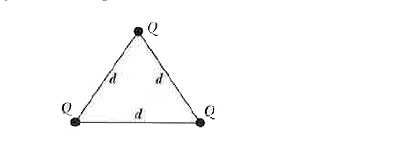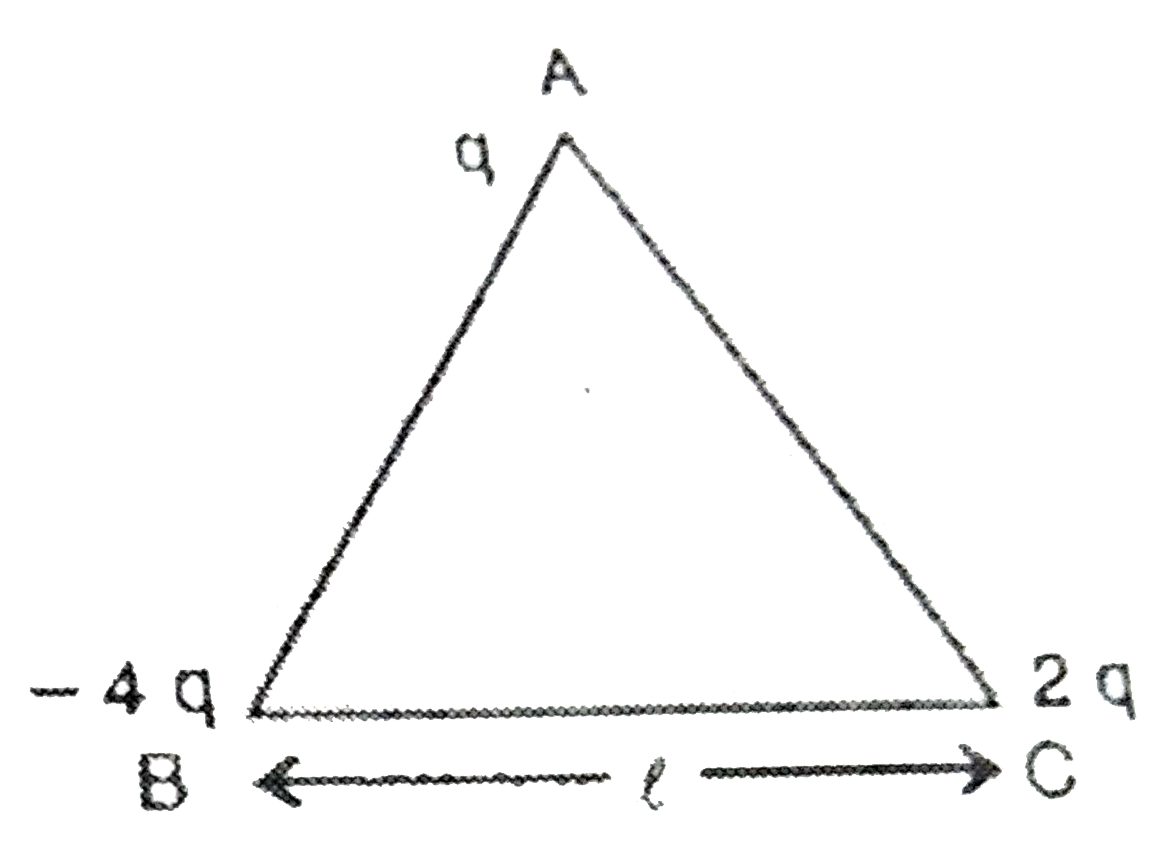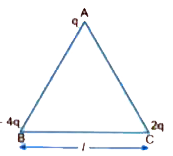A point charge +Q is placed at the centroid of an equilateral triangle. When a second charge +Q is placed at a vertex of the triangle, the magnitude of the electrostatic force on the central charge is 8 N. The magnitude of the net force on the central charge when a third charge +Q is placed at another vertex of the triangle is
zero
4N
4(√2)N
8N
The correct Answer is:D
To find the magnitude of the net force on the central charge when a third charge +Q is placed at another vertex of the triangle, we can follow these steps:
Step 1: Understand the Configuration
We have an equilateral triangle with a charge +Q at the centroid and two other charges +Q placed at two vertices. The forces acting on the central charge due to these vertex charges will be symmetrical.
Step 2: Analyze the Forces
When the second charge +Q is placed at one vertex, it exerts a force of 8 N on the central charge. This force acts along the line connecting the vertex charge and the central charge.
Step 3: Introduce the Third Charge
When we place the third charge +Q at the other vertex of the triangle, it will also exert a force of 8 N on the central charge, directed towards the centroid.
Step 4: Determine the Angle Between Forces
The angle between the forces exerted by the two vertex charges on the central charge is 120 degrees (since the angle between the lines connecting the centroid to the vertices of an equilateral triangle is 60 degrees, and we have two forces acting in opposite directions).
Step 5: Calculate the Resultant Force
To find the net force Fnet on the central charge due to both vertex charges, we can use the formula for the resultant of two forces:
Fnet=√F21+F22+2F1F2cos(θ)
where:
- F1=8N
- F2=8N
- θ=120∘
Substituting the values:
Fnet=√82+82+2⋅8⋅8⋅cos(120∘)
Since cos(120∘)=−12:
Fnet=√64+64−64=√64=8N
Conclusion
The magnitude of the net force on the central charge when a third charge +Q is placed at another vertex of the triangle is 8 N.
We have an equilateral triangle with a charge +Q at the centroid and two other charges +Q placed at two vertices. The forces acting on the central charge due to these vertex charges will be symmetrical.
When the second charge +Q is placed at one vertex, it exerts a force of 8 N on the central charge. This force acts along the line connecting the vertex charge and the central charge.
When we place the third charge +Q at the other vertex of the triangle, it will also exert a force of 8 N on the central charge, directed towards the centroid.
The angle between the forces exerted by the two vertex charges on the central charge is 120 degrees (since the angle between the lines connecting the centroid to the vertices of an equilateral triangle is 60 degrees, and we have two forces acting in opposite directions).
To find the net force Fnet on the central charge due to both vertex charges, we can use the formula for the resultant of two forces:
Fnet=√F21+F22+2F1F2cos(θ)
where:
- F1=8N
- F2=8N
- θ=120∘
Fnet=√82+82+2⋅8⋅8⋅cos(120∘)
Since cos(120∘)=−12:
Fnet=√64+64−64=√64=8N
The magnitude of the net force on the central charge when a third charge +Q is placed at another vertex of the triangle is 8 N.
Topper's Solved these Questions
- BOOK - CENGAGE PHYSICSCHAPTER - MISCELLANEOUS VOLUME 3EXERCISE - Multiple Correct Answer type109videos
MISCELLANEOUS VOLUME 3
- BOOK - CENGAGE PHYSICSCHAPTER - MISCELLANEOUS VOLUME 3EXERCISE - Assertion and Reason Type8videos
MISCELLANEOUS VOLUME 3
- BOOK - CENGAGE PHYSICSCHAPTER - MECHANICAL PROPERTIES OF SOLIDSEXERCISE - Question Bank4videos
MECHANICAL PROPERTIES OF SOLIDS
- BOOK - CENGAGE PHYSICSCHAPTER - MISCELLANEOUS VOLUME 5EXERCISE - Integer12videos
MISCELLANEOUS VOLUME 5
Similar Questions
Consider the charges q,q and -q placed at the vertices of an equilateral triangle of each side l. What is the force on each charge ?
View SolutionA charge "q" is placed at the centroid of an equilateral triangle. Three charges having same "],[" charge equal to "Q" are placed at the vertices of the triangle.The system of four charges will be in equilibrium if "q" is equal to
View Solution
Knowledge Check
- Question 1 - Select One
Three charges each of value q are placed at the corners of an equilateral triangle. A fourth charge Q is placed at the centre of the triangle. If Q=−q:
Athe charges will move towards the centreBthe charges will move away from the centreCthe charges will remain stationaryDthe charges may move in any direction - Question 2 - Select One
Three point charges are placed at the corner of an equilateral triangle. Assuming only electrostatic forces are acting.
Athe system can never be in equilibriumBthe system will be equilibrium if the charges rotate about the centre of the triangleCthe system will be in equilibrium if the charges have different magnitudes and different signsDthe system will be in equilibrium if the charges have the same magnitude but different signs. - Question 3 - Select One
Three identical point charges, q, are placed at the vertices of an equilateral triangle as shown in the figure. The length of each side of the triangle is d. Determine the magnitude and direction of the total electrostatic force on the charge at the top of the triangle.
 AQ2√34πε0d2, directed upwardBQ2√34πε0d2, directed downwardCQ2√32πε0d2, directed upwardDQ2√32πε0d2, directed downward
AQ2√34πε0d2, directed upwardBQ2√34πε0d2, directed downwardCQ2√32πε0d2, directed upwardDQ2√32πε0d2, directed downward
(a) Three point charges q,-4q and 2q are placed at the vertices of an equilateral triangle ABC of side 'l' as shown in the figure. Obtain the expression for the magnitude of the resultant electric force acting on the charge q.
(b) Find out the amount of the work done to separate the charges at infinite distance.
 View Solution
View SolutionThree charges, each of value q, are placed at the comers of an equilateral triangle. A fourth charge Q is placed at the centre of the triangle. If the value of Q for which charges remain stationary is (−q√n), then find n.
View SolutionThree point charges q,−4q and 2q are placed at the vertices of an equilateral triangle ABC of side 'l' as shown in the Fig. Obtain the experssion for the magnitude of the resultant electric force acting on the charge q.
 View Solution
View SolutionThree point charges q are placed at three vertices of an equilateral triangle of side a. Find magnitude of electric force on any charge due to the other two.
View SolutionIf 3 charges are placed at the vertices of equilateral triangle of charge 'q' each. What is the net potential energy, if the side of equilateral Δ is l cm ?
View Solution

